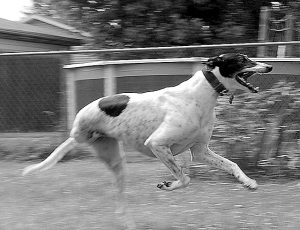AMPUTATION
Overview
 Our dog and cat friends & family are lucky; not only do they have us (!), they have four legs. These four legs gives them the edge when running fast; their four legs allow them to jump and climb better than us; and those four legs offer a surplus when medical conditions harm one of the legs. It is often hard for us humans to understand this benefit of four legs when it comes to losing one leg; when we lose a leg, it often means we must significantly adjust our lifestyle. And until and unless it happens to us or someone close to us, we will never fully appreciate the effect losing a limb will have. Similarly, until and unless we share time with a dog or cat who has lost a limb, we rarely appreciate how so very well they accommodate and adjust to three (or even two) legged status.
Our dog and cat friends & family are lucky; not only do they have us (!), they have four legs. These four legs gives them the edge when running fast; their four legs allow them to jump and climb better than us; and those four legs offer a surplus when medical conditions harm one of the legs. It is often hard for us humans to understand this benefit of four legs when it comes to losing one leg; when we lose a leg, it often means we must significantly adjust our lifestyle. And until and unless it happens to us or someone close to us, we will never fully appreciate the effect losing a limb will have. Similarly, until and unless we share time with a dog or cat who has lost a limb, we rarely appreciate how so very well they accommodate and adjust to three (or even two) legged status.
Surgical Amputation
The most common location for removing a damaged or diseased limb in dogs and cats is up high where the limb meets the body. This is so that any remaining portion of the leg does not become a problem for the pet. Any portion of a limb that remains may become traumatized during daily activities or interfere with movement.
For the front leg, the most successful and cosmetic amputation is by “scapular disarticulation”; this means that the entire limb is removed from the toes to the scapula (shoulder blade). Since the normal anatomy of the front leg only has muscles that attach the front leg to the chest wall, it is straightforward to remove the limb by cutting these muscles and sewing the area closed. This complete removal creates a smooth, well padded amputation site on the side of the chest that will not get pressure sores or interfere with movement in anyway.
For the rear leg, there are two techniques that are commonly used. The first is a “high femur” amputation that results in a short, well padded stump at the level of the rump/thigh. The muscles of the mid-thigh are cut and the femur (thigh bone) is cut close to the hip. When the tissues are sewn together, this provides good padding for the pelvis when the pet is lying down and offers a cosmetic appearance by maintaining symmetry of the rump area. The second technique is often use when the disease of the rearleg is in the thigh area; the leg is removed by “coxofemoral (hip) disarticulation”. This means that the leg is removed at the hip joint; only the pelvis and the surrounding muscles remain. This amputation technique is very successful as well, with slightly less padding over the amputation site and a less symmetrical appearance.
People are often interested in saving more of the leg if the injury or disease is low on the leg. This is not recommended in the majority of patients for the reasons mentioned above. But in cases where multiple legs are compromised and preserving leg function is preferred or required, there have been some successful cases of prosthetic limbs being created for and used by pets. This field is not as well developed in animals as it is in humans; cases must be evaluated individually with veterinary surgeon and human prosthetic specialist working together to create a successful outcome. Ongoing management of prosthetic limbs in animals requires a strong commitment from the pet’s owner.
Summary
 You may be facing this decision whether or not to proceed with a limb amputation for your pet. It may be recommended because of cancer or severe trauma, or a birth defect may have created a useless leg. Regardless of the cause, the decision to proceed with amputation is a big one. Understanding the procedure and the expectations for life after surgery may help guide you in your decision-making. If you have access to the Internet, you may find online chat groups for people with pet amputees to share your story and ask for input. Your veterinarian or surgeon may be able to introduce you to fellow clients with pet amputees with whom you can discuss life issues for an amputee.
You may be facing this decision whether or not to proceed with a limb amputation for your pet. It may be recommended because of cancer or severe trauma, or a birth defect may have created a useless leg. Regardless of the cause, the decision to proceed with amputation is a big one. Understanding the procedure and the expectations for life after surgery may help guide you in your decision-making. If you have access to the Internet, you may find online chat groups for people with pet amputees to share your story and ask for input. Your veterinarian or surgeon may be able to introduce you to fellow clients with pet amputees with whom you can discuss life issues for an amputee.
A limb amputation, though scary, may be a very successful solution to a difficult medical condition. Dogs and cats can relatively easily accommodate the loss of one of their four legs; some pets are even known to live wonderfully active lives with only two legs. With help and support from their human family, pet amputees can live a rich and enjoyable life.
www.acvs.org
